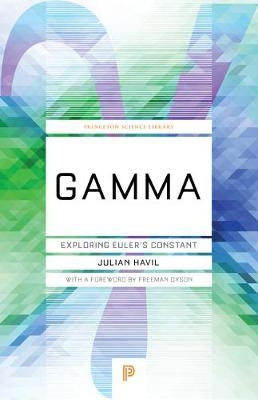
Gamma
Princeton University Press (Verlag)
978-0-691-17810-3 (ISBN)
Sure to be popular with not only students and instructors but all math aficionados, Gamma takes us through countries, centuries, lives, and works, unfolding along the way the stories of some remarkable mathematics from some remarkable mathematicians.
Julian Havil is a retired former master at Winchester College, England, where he taught mathematics for thirty-three years. He received a Ph.D. in mathematics from Oxford University. Freeman Dyson is professor emeritus of physics at the Institute for Advanced Study in Princeton. He is the author of several books, including Disturbing the Universe and Origins of Life.
Foreword xv Acknowledgements xvii Introduction xix Chapter One The Logarithmic Cradle 1 1.1 A Mathematical Nightmare- and an Awakening 1 1.2 The Baron's Wonderful Canon 4 1.3 A Touch of Kepler 11 1.4 A Touch of Euler 13 1.5 Napier's Other Ideas 16 Chapter Two The Harmonic Series 21 2.1 The Principle 21 2.2 Generating Function for Hn 21 2.3 Three Surprising Results 22 Chapter Three Sub-Harmonic Series 27 3.1 A Gentle Start 27 3.2 Harmonic Series of Primes 28 3.3 The Kempner Series 31 3.4 Madelung's Constants 33 Chapter Four Zeta Functions 37 4.1 Where n Is a Positive Integer 37 4.2 Where x Is a Real Number 42 4.3 Two Results to End With 44 Chapter Five Gamma's Birthplace 47 5.1 Advent 47 5.2 Birth 49 Chapter Six The Gamma Function 53 6.1 Exotic Definitions 53 6.2 Yet Reasonable Definitions 56 6.3 Gamma Meets Gamma 57 6.4 Complement and Beauty 58 Chapter Seven Euler's Wonderful Identity 61 7.1 The All-Important Formula 61 7.2 And a Hint of Its Usefulness 62 Chapter Eight A Promise Fulfilled 65 Chapter Nine What Is Gamma Exactly? 69 9.1 Gamma Exists 69 9.2 Gamma Is What Number? 73 9.3 A Surprisingly Good Improvement 75 9.4 The Germ of a Great Idea 78 Chapter Ten Gamma as a Decimal 81 10.1 Bernoulli Numbers 81 10.2 Euler -Maclaurin Summation 85 10.3 Two Examples 86 10.4 The Implications for Gamma 88 Chapter Eleven Gamma as a Fraction 91 11.1 A Mystery 91 11.2 A Challenge 91 11.3 An Answer 93 11.4 Three Results 95 11.5 Irrationals 95 11.6 Pell's Equation Solved 97 11.7 Filling the Gaps 98 11.8 The Harmonic Alternative 98 Chapter Twelve Where Is Gamma? 101 12.1 The Alternating Harmonic Series Revisited 101 12.2 In Analysis 105 12.3 In Number Theory 112 12.4 In Conjecture 116 12.5 In Generalization 116 Chapter Thirteen It's a Harmonic World 119 13.1 Ways of Means 119 13.2 Geometric Harmony 121 13.3 Musical Harmony 123 13.4 Setting Records 125 13.5 Testing to Destruction 126 13.6 Crossing the Desert 127 13.7 Shuffiing Cards 127 13.8 Quicksort 128 13.9 Collecting a Complete Set 130 13.10 A Putnam Prize Question 131 13.11 Maximum Possible Overhang 132 13.12 Worm on a Band 133 13.13 Optimal Choice 134 Chapter Fourteen It's a Logarithmic World 139 14.1 A Measure of Uncertainty 139 14.2 Benford's Law 145 14.3 Continued-Fraction Behaviour 155 Chapter Fifteen Problems with Primes 163 15.1 Some Hard Questions about Primes 163 15.2 A Modest Start 164 15.3 A Sort of Answer 167 15.4 Picture the Problem 169 15.5 The Sieve of Eratosthenes 171 15.6 Heuristics 172 15.7 A Letter 174 15.8 The Harmonic Approximation 179 15.9 Different-and Yet the Same 180 15.10 There are Really Two Questions, Not Three 182 15.11 Enter Chebychev with Some Good Ideas 183 15.12 Enter Riemann, Followed by Proof(s)186 Chapter Sixteen The Riemann Initiative 189 16.1 Counting Primes the Riemann Way 189 16.2 A New Mathematical Tool 191 16.3 Analytic Continuation 191 16.4 Riemann's Extension of the Zeta Function 193 16.5 Zeta's Functional Equation 193 16.6 The Zeros of Zeta 193 16.7 The Evaluation of (x) and p(x)196 16.8 Misleading Evidence 197 16.9 The Von Mangoldt Explicit Formula-and How It Is Used to Prove the Prime Number Theorem 200 16.10 The Riemann Hypothesis 202 16.11 Why Is the Riemann Hypothesis Important? 204 16.12 Real Alternatives 206 16.13 A Back Route to Immortality-Partly Closed 207 16.14 Incentives, Old and New 210 16.15 Progress 213 Appendix A The Greek Alphabet 217 Appendix B Big Oh Notation 219 Appendix C Taylor Expansions 221 C.1 Degree 1 221 C.2 Degree 2 221 C.3 Examples 223 C.4 Convergence 223 Appendix D Complex Function Theory 225 D.1 Complex Differentiation 225 D.2 Weierstrass Function 230 D.3 Complex Logarithms 231 D.4 Complex Integration 232 D.5 A Useful Inequality 235 D.6 The Indefinite Integral 235 D.7 The Seminal Result 237 D.8 An Astonishing Consequence 238 D.9 Taylor Expansions-and an Important Consequence 239 D.10 Laurent Expansions-and Another Important Consequence 242 D.11 The Calculus of Residues 245 D.12 Analytic Continuation 247 Appendix E Application to the Zeta Function 249 E.1 Zeta Analytically Continued 249 E.2 Zeta's Functional Relationship 253 References 255 Name Index 259 Subject Index 263
| Erscheinungsdatum | 16.12.2017 |
|---|---|
| Reihe/Serie | Princeton Science Library |
| Vorwort | Freeman Dyson |
| Zusatzinfo | 89 b/w illus., 20 tables |
| Verlagsort | New Jersey |
| Sprache | englisch |
| Maße | 140 x 216 mm |
| Gewicht | 255 g |
| Themenwelt | Sachbuch/Ratgeber ► Natur / Technik |
| Geisteswissenschaften ► Geschichte | |
| Mathematik / Informatik ► Mathematik ► Analysis | |
| ISBN-10 | 0-691-17810-0 / 0691178100 |
| ISBN-13 | 978-0-691-17810-3 / 9780691178103 |
| Zustand | Neuware |
| Haben Sie eine Frage zum Produkt? |
aus dem Bereich


